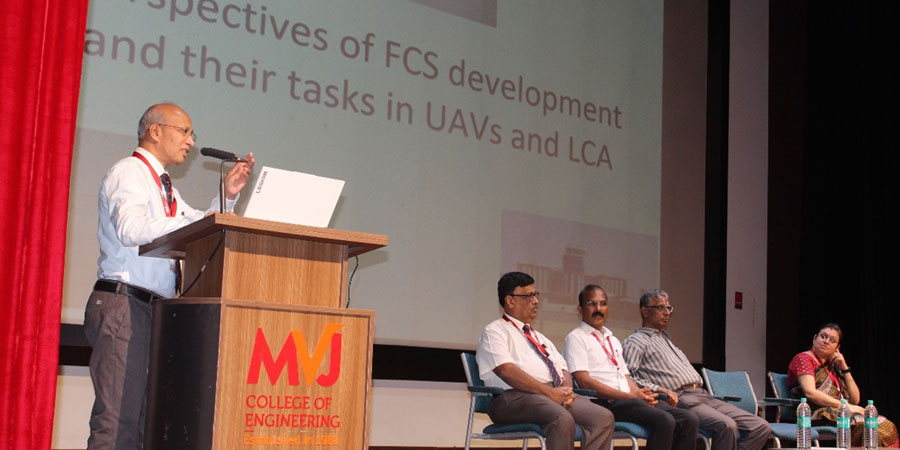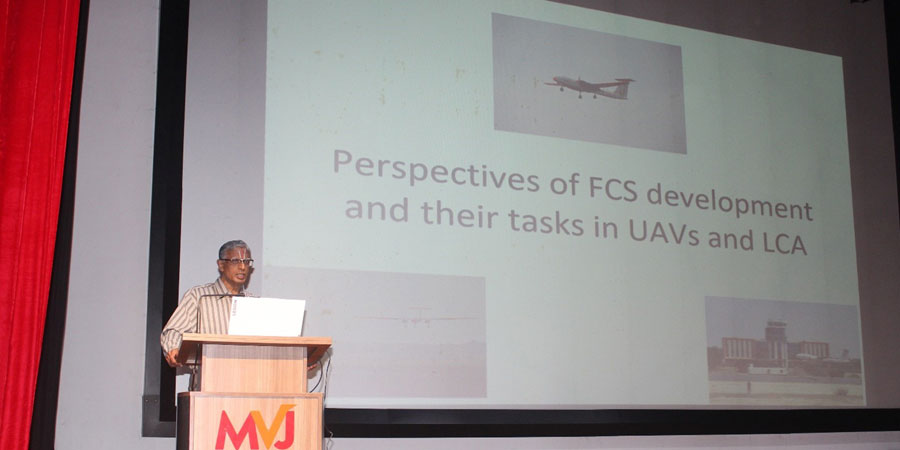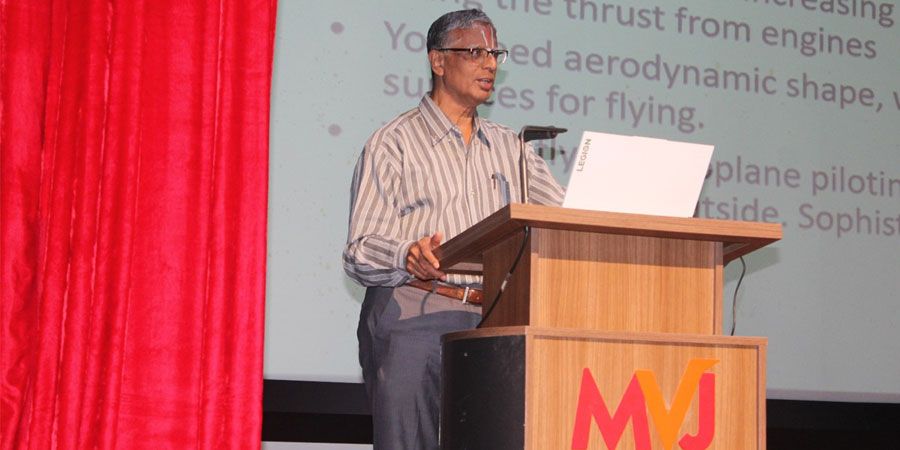Unmanned Aerial Vehicles
The Department of Mechanical Engineering, Aeronautical Engineering, and Aerospace Engineering organized a guest lecture on Unmanned Aerial Vehicles by Shri P S Krishnan, a Member of the Board of Governors (BoG) at MVJCE and Former Director at ADE Labs, DRDO. The lecture took place on July 24, 2023, a Monday, at the Dr. M V Jayaraman Auditorium, running from 10:30 AM to 01:00 PM. The guest lecture was specifically intended for 4th semester students of Mechanical Engineering, Aeronautical Engineering, and Aerospace Engineering. A total of 37 students from the 4th semester of Mechanical Engineering, 43 students from the 4th semester of Aeronautical Engineering, and 82 students from the 4th semester of Aerospace Engineering participated in the event.
The program commenced in the distinguished presence of Principal Dr. V Suresh Babu and Vice Principal Dr. M Brindha. Dr. Shrinivas Gombi, the Head of the Department of Mechanical Engineering, delivered an introduction highlighting the significance of the guest lecture to the audience. Dr. A C Niranjan, Professor and Head of the Department of Aerospace Engineering, extended a warm welcome to the chief guest and provided an insightful background of Shri P S Krishnan's work at ADE Labs. Miss. Jhanavi and Miss. Binso Prince, both from the 4th Semester of Aerospace Engineering, served as the anchors for the program.
The chief guest Shri P S Krishnan addressed the students and emphasized the need for unmanned aerial vehicles. He further highlighted the efforts of the college in organizing such events to equip students and nurture them to bridge the gap between industry and academia. He shared his rich experience in the domain of unmanned aerial vehicles, especially with respect to the perspectives of Future Combat Systems (FCS) development and their tasks in light combat aircraft (LCA) and Unmanned Aerial Vehicles.

Dr. A C Niranjan, Professor and Head, Department of AS, MVJCE welcoming the chief guest and giving an overview of his achievements.
Unmanned Aerial Vehicles (UAVs), commonly known as drones, have emerged as a revolutionary technology in the aviation industry. These aircraft operate without the need for a human pilot on board and can be either remotely controlled by a human operator or guided autonomously through pre-programmed instructions or artificial intelligence algorithms. Their increasing popularity can be attributed to their versatility, cost-effectiveness, and ability to access challenging or hazardous environments that are often inaccessible or risky for manned aircraft.
UAVs come in various types, each catering to specific needs and applications. Consumer drones, for instance, are designed for recreational purposes, aerial photography, and videography, equipped with high-resolution cameras and controllable through smartphone apps or dedicated remote controllers. On the other end of the spectrum, military drones play a crucial role in military operations, intelligence gathering, surveillance, reconnaissance, and target acquisition. Some military drones are even armed and utilized for combat missions.
Commercial drones have found extensive use across businesses and industries for applications such as aerial surveying, mapping, agriculture, infrastructure inspection, delivery services, and environmental monitoring. Meanwhile, research drones are employed by scientists and researchers for scientific data collection, wildlife monitoring, atmospheric research, and various environmental studies.
The key components of UAVs include the frame, which provides the physical structure holding all the components together and is typically made of lightweight materials like carbon fiber or aluminum. The propulsion system, powered by electric motors or internal combustion engines, drives the propellers or rotors for flight. The navigation system, comprising GPS receivers and various sensors like accelerometers, gyroscopes, and altimeters, determines the UAV's position, orientation, and altitude. The control system, encompassing both hardware and software, is responsible for stabilizing the UAV, controlling its flight path, and responding to user or autonomous inputs. The communication system enables seamless data exchange and commands between the UAV and the ground control station, usually employing radio frequency (RF) communication. Additionally, UAVs can carry a payload, which includes equipment or cargo such as cameras, sensors, or other specialized devices based on the specific application they serve.
Shri P S Krishnan also laid emphasis on the technological and cost-effectiveness compared to traditional manned aircraft, making them accessible for a wide range of applications. Moreover, by removing the need for a human pilot on board, they can be deployed in dangerous or hazardous environments, thus reducing the risk to human life. Their adaptability and versatility enable their use in diverse scenarios, from recreational pursuits to critical military missions, environmental monitoring, and commercial services. Drones' efficiency in covering large areas swiftly and reaching remote or challenging locations makes them invaluable for tasks like surveying and data collection.
He also laid emphasis on striking a balance between harnessing the benefits of UAVs and addressing their potential drawbacks, which remains an ongoing challenge for governments, industries, and society as a whole.

Shri P S Krishnan, BoG- Member, MVJCE and Former Director, ADE giving an introduction about his presentation

Shri P S Krishnan, BoG- Member, MVJCE and Former Director, ADE explaining the importance of navigation control and guidance for UAV’s

Students and Faculty keenly listening to the guest lecture by the Chief Guest.
The event was well appreciated by the students and faculty members of Mechanical, Aeronautical and Aerospace Engineering. The guest lecture concluded with the vote of thanks by Dr. A C Niranjan, HoD, Department of Aerospace Engineering, and concluding remarks by Dr. Shrinivas Gombi, HoD, Department of Mechanical Engineering.
Outcomes of the Event:
The students and faculty appreciated the event and were able to
- Acquire the knowledge about Unmanned Aerial Vehicles.
- Understanding the Practical importance of UAV.
- An ability to acquire and apply new knowledge in building newer UAV’s.
- Right Understanding of decision-making and product development for innovative projects related to UAV.
Discussions were held with the chief guest about the development of newer projects related to UAV and Industrial Visit to ADE Labs. Resource person positively responded to the request and assured to collaborate with both the departments for guiding students for Industrial Visit and for UAV related projects.





